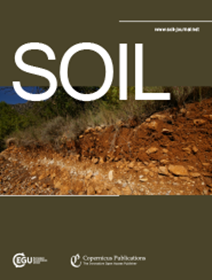The clay mineralogy rather that the clay content determines radiocaesium adsorption in soils
IF 5.8
2区 农林科学
Q1 SOIL SCIENCE
引用次数: 0
Abstract
Abstract. The transfer of radiocaesium (137Cs) from soil to crops is the main long-term radiation risk after nuclear accidents. The prevailing concept is that 137Cs sorption in soil, and hence its bioavailability, is controlled by soil clay content (0–2 µm). This study tested this assumption using 24 soils collected worldwide. The Radiocaesium Interception Potential (RIP), i.e., 137Cs adsorption, was measured for the bulk soils and for their clay and silt fractions. The RIP varied by factor 438 among soils and was unrelated to its clay content (p >0.05). The RIP in the clay fractions was lowest for young volcanic soils with allophane and mica, and for highly weathered tropical soils with kaolinite. In contrast, about two order of magnitude higher RIP values were found in intermediate-weathered temperate soils dominated by illite. Soil RIP was, hence, related to soil illite content (R2 = 0.50; p <0.001). Significant fraction of soil RIP originated from clay minerals embedded in the silt fraction. The sum of RIP in clay and silt fractions overestimated the soil RIP by, on average, factor of 2, indicating that isolation of clay opens selective 137Cs sorption sites inaccessible in intact soils. Soil mineralogy, not just clay content, governs soil RIP. The validity of existing 137Cs bioavailability models require recalibration for its use on a global scale.粘土矿物学而不是粘土含量决定土壤对放射性铯的吸附
摘要。放射性铯(137Cs)从土壤向作物的转移是核事故后主要的长期辐射风险。目前流行的观点是,土壤对137Cs的吸收及其生物利用度受土壤粘土含量(0-2µm)的控制。这项研究使用了世界各地收集的24种土壤来验证这一假设。测量了块状土壤及其粘土和粉土组分的放射性铯拦截电位(RIP),即137Cs的吸附。不同土壤的RIP差异因子为438,与粘土含量无关(p >0.05)。含铁矾和云母的年轻火山土和含高岭石的高风化热带土中,粘土组分的RIP最低。相比之下,以伊利石为主的中风化温带土壤的RIP值大约高出两个数量级。因此,土壤RIP与土壤伊利石含量相关(R2 = 0.50;p & lt; 0.001)。很大一部分土壤RIP来自于埋在粉土组分中的粘土矿物。粘土和粉土组分中RIP的总和平均高估了土壤RIP的2倍,这表明粘土的分离打开了完整土壤中无法获得的选择性137Cs吸附位点。土壤矿物学,而不仅仅是粘土含量,决定着土壤的RIP。现有137Cs生物利用度模型的有效性需要重新校准,以便在全球范围内使用。
本文章由计算机程序翻译,如有差异,请以英文原文为准。
求助全文
约1分钟内获得全文
求助全文
来源期刊

Soil
Agricultural and Biological Sciences-Soil Science
CiteScore
10.80
自引率
2.90%
发文量
44
审稿时长
30 weeks
期刊介绍:
SOIL is an international scientific journal dedicated to the publication and discussion of high-quality research in the field of soil system sciences.
SOIL is at the interface between the atmosphere, lithosphere, hydrosphere, and biosphere. SOIL publishes scientific research that contributes to understanding the soil system and its interaction with humans and the entire Earth system. The scope of the journal includes all topics that fall within the study of soil science as a discipline, with an emphasis on studies that integrate soil science with other sciences (hydrology, agronomy, socio-economics, health sciences, atmospheric sciences, etc.).
 求助内容:
求助内容: 应助结果提醒方式:
应助结果提醒方式:


